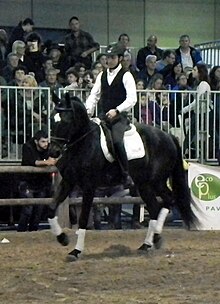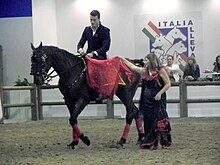 At Fieracavalli, Verona, in 2014 At Fieracavalli, Verona, in 2014 | |
| Conservation status | FAO (2007): endangered |
|---|---|
| Other names | Salerno horse |
| Country of origin | Italy |
| Distribution | |
| Use | |
| Traits | |
| Height |
|
| Colour | |
| Breed standards | |

The Salernitano is an endangered Italian breed of horse. It originates from the floodplain of the Sele river, in the province of Salerno in southern Italy. It was formerly used as a military horse, but in the twentieth century became principally a sport horse.
History
The Salernitano originates in the floodplains of the Sele river in the comuni of Battipaglia, Capaccio and Eboli, in the province of Salerno in Campania in southern Italy. From the time of the Republic of Amalfi and during the crusades, the local horses of the area were influenced by Oriental blood. Under the Bourbons there were influences from Spanish horses and again from the Orient. From the early years of the nineteenth century, Thoroughbred and – to a lesser extent – Hackney blood was used to improve military aptitudes. From the 1920s the Salernitano began to be used as a sport horse, in flat racing, over jumps and in show-jumping. After the Second World War there was little demand for cavalry horses, and the breed was used mostly for sports. The Campania regional administration started a conservation programme for the breed in the 1970s. In 1990 the total number was estimated at 100. In 2007 the FAO recorded the conservation status of the breed as "endangered".
The Salernitano was formerly registered together with the Persano, which originates from much the same area and shares some of the same history. In 2015, the two breeds were recognised as separate by the Ministero delle Politiche Agricole Alimentari e Forestali, the Italian ministry of agriculture.
Characteristics
The usual coat colour is bay; chestnut, grey and black are also accepted.
Use
The Salernitano is suitable for use as a riding horse, as a harness horse, for equestrian touring and horse-trekking, and for sports, particularly show-jumping.
References
- ^ Barbara Rischkowsky, D. Pilling (eds.) (2007). List of breeds documented in the Global Databank for Animal Genetic Resources, annex to The State of the World's Animal Genetic Resources for Food and Agriculture. Rome: Food and Agriculture Organization of the United Nations. ISBN 9789251057629. Accessed January 2017.
- ^ Daniele Bigi, Alessio Zanon (2008). Atlante delle razze autoctone: Bovini, equini, ovicaprini, suini allevati in Italia (in Italian). Milan: Edagricole. ISBN 9788850652594.
- Valerie Porter, Lawrence Alderson, Stephen J.G. Hall, D. Phillip Sponenberg (2016). Mason's World Encyclopedia of Livestock Breeds and Breeding (sixth edition). Wallingford: CABI. ISBN 9781780647944.
- Breed data sheet: Salernitano/Italy. Domestic Animal Diversity Information System of the Food and Agriculture Organization of the United Nations. Accessed January 2017.
- ^ Gaio Cacopardi (23 January 2015). DM RA modifiche norme tecniche 2015/SR (in Italian). Ministero delle Politiche Agricole Alimentari e Forestali. Accessed January 2017.
![]() Media related to Salernitano at Wikimedia Commons
Media related to Salernitano at Wikimedia Commons
| Horse breeds of Italy | |
|---|---|
| These are the horse breeds considered in Italy to be wholly or partly of Italian origin. Many have complex or obscure histories, so inclusion here does not necessarily imply that a breed is predominantly or exclusively Italian. | |
| |
| List of horse breeds |